WD Black SN750 SSD Review: A Not so Fresh Refresh (Updated)
WD's new Black SN750 offers a surprisingly good performance upgrade through firmware and software tweaks.
Why you can trust Tom's Hardware
Performance Results for 1TB WD Black SN750
Rating: ★★★★
Verdict: The Black SN750 uses the same hardware as the previous model and comes with the same endurance ratings and five-year warranty coverage, too, but this time around it has an updated firmware that boosts performance. The drives also includes an updated SSD dashboard, a 2TB option, and a model with a sleek heatsink, making it a solid choice if you're willing to pay few dollars more.
+ FOR
- Great performance in applications
- Impressive power efficiency
- Back PCB with EKBW heatsink option
- Software package included
- AGAINST
- Could use a few more firmware optimizations
- Pricey
Comparison Products for 1TB WD Black SN750
We put the new Black SN750 against the previous-gen Black as well as the popular Samsung 970 EVO, top-performing Samsung 970 Pro, the new Adata XPG SX8200 Pro, and a MyDigitalSSD BPX Pro with the new 12.1 firmware update applied. We also included the cheapest NVMe SSD option from Intel, the Intel SSD 660p, and a Crucial MX500 SATA SSD.
As with all of our testing, we put the Black SN750 through its paces with all of the power saving features disabled. That means the SSD is effectively in what WD calls "game mode" during our testing.
Trace Testing – PCMark 8 Storage Test 2.0
PCMark 8 is a trace-based benchmark that uses Microsoft Office, Adobe Creative Suite, World of Warcraft, and Battlefield 3 to measure the performance of storage devices in real-world scenarios.
Get Tom's Hardware's best news and in-depth reviews, straight to your inbox.

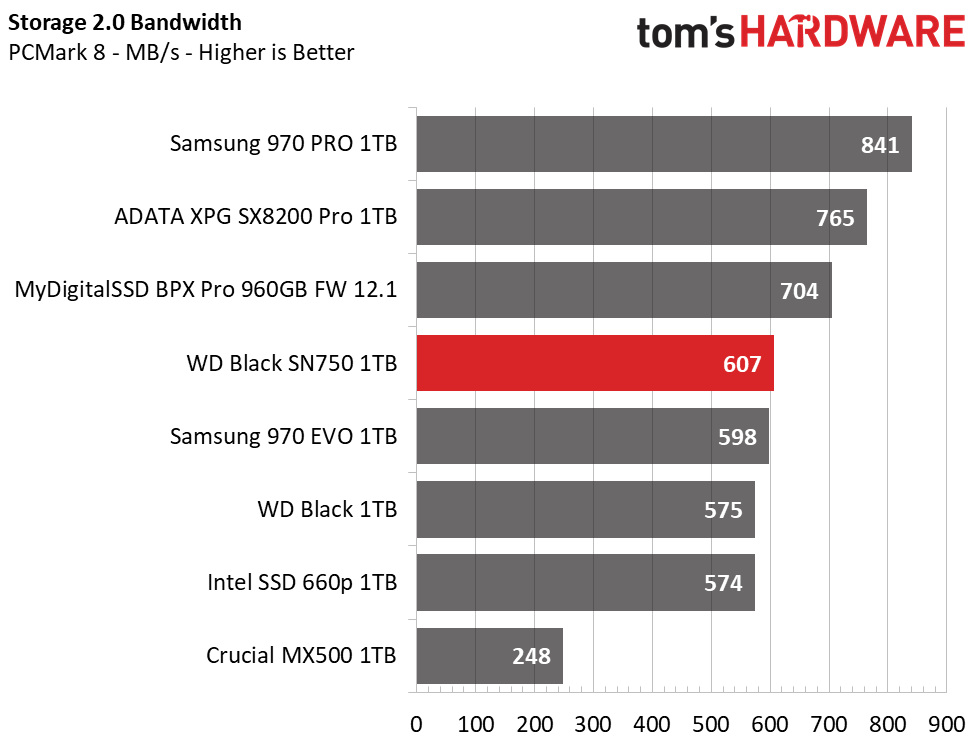
The updated WD Black boasts slightly improved performance in PCMark 8’s Storage 2.0 test, but the new firmware on the Phison E12-powered BPX Pro and the ADATA XPG SX8200 Pro's new SM2262EN controller are tough to beat. The Black SN750 ranks fourth overall.
Game Scene Loading - Final Fantasy XIV
The Final Fantasy XIV StormBlood benchmark is a free real-world game benchmark that easily and accurately compares game load times without the inaccuracy of using a stopwatch.
WD improved game loading as well. The Black SN750 lands in fourth place, nearly tying with the Samsung 970 Pro. The 20.56-second total load time represents nearly a one second improvement over the previous-gen Black.
Transfer Rates – DiskBench
We use the DiskBench storage benchmarking tool to test file transfer performance with our own custom 50GB block of data. Our data set includes 31,227 files of various types, like pictures, PDFs, and videos. We copy the files to a new folder and then follow up with a read test of a newly-written 6 GB file.


File copy and read performance was a strong suit of the previous WD Black, but the new model notched a 22MB/s improvement. The Black SN750 beats the Samsung 970 Pro and steals second place, landing just behind the Intel Optane SSD 905P. More impressively, the drive took the overall lead during the read test.
SYSmark 2014 SE
Like PCMark, SYSmark uses real applications to measure system performance. SYSmark takes things much further, however. It uses fourteen different applications to run real workloads with real data sets to measure how overall system performance impacts the user experience. BAPCo's SYSmark 2014 SE installs a full suite of applications for its tests, which includes Microsoft Office, Google Chrome, Corel WinZip, several Adobe software applications, and GIMP. That also makes it a great test to measure the amount of time it takes to install widely-used programs after you install a fresh operating system.


WD’s Black SN750 installed SYSmark in the same time as the Intel Optane SSD 905P, which very few other SSDs have yet to do, and finished with a 1,700-point responsiveness score. This is a minor 10-point improvement over the previous model, but it is similar to most of the other SSDs in our test pool. The Black SN750 also offers a bit more performance than the SATA MX500. It's also light years ahead of any HDD.
ATTO
ATTO is a simple and free application that SSD vendors commonly use to assign sequential performance specifications to their products. It also gives us insight into how the device handles different file sizes.
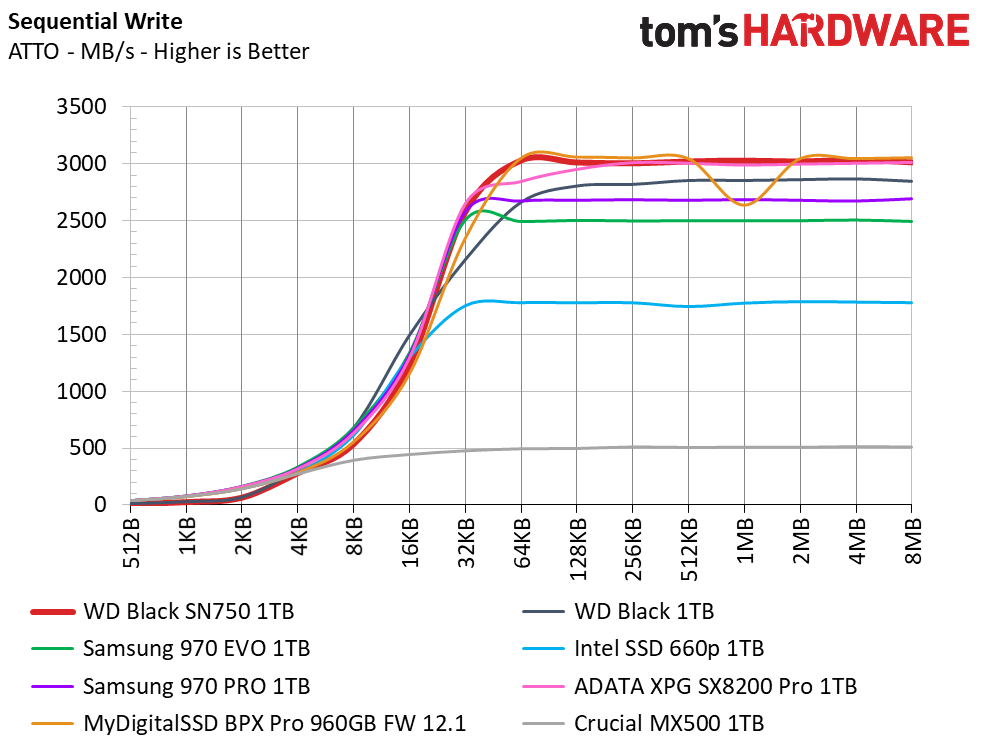

WD’s Black SN750 provides great performance during sequential workloads. WD’s firmware improvements focused on improving small-file read performance, although there was a hiccup with 128KB files as performance fell to 1,500MB/s. The drive peaked at over 3.5/3.0GB/s of read/write throughput, keeping up with the best of the best and leaving any SATA-based SSD or HDD in the dust.
Anvil's Storage Utilities
Anvil's Storage Utility is a commonly-referenced benchmark that simplifies the complex IOMETER benchmark and its underlying Dynamo engine with a one-click software wrapper.



The WD Black would have maintained second place overall if we didn't add the XPG SX8200 Pro and updated BPX Pro results at the last minute. Overall, the SN750 landed in third place. This again proves the new firmware helps the drive surpass the Samsung 970 EVO.
CrystalDiskMark
CrystalDiskMark (CDM) is a simple and easy to use file size benchmarking tool.



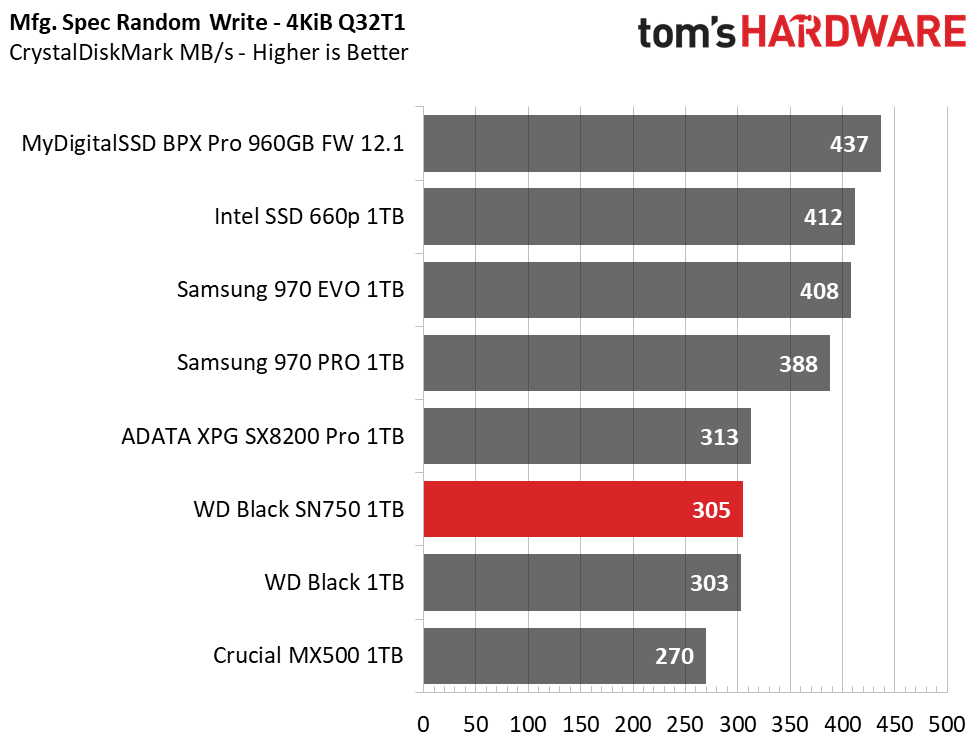
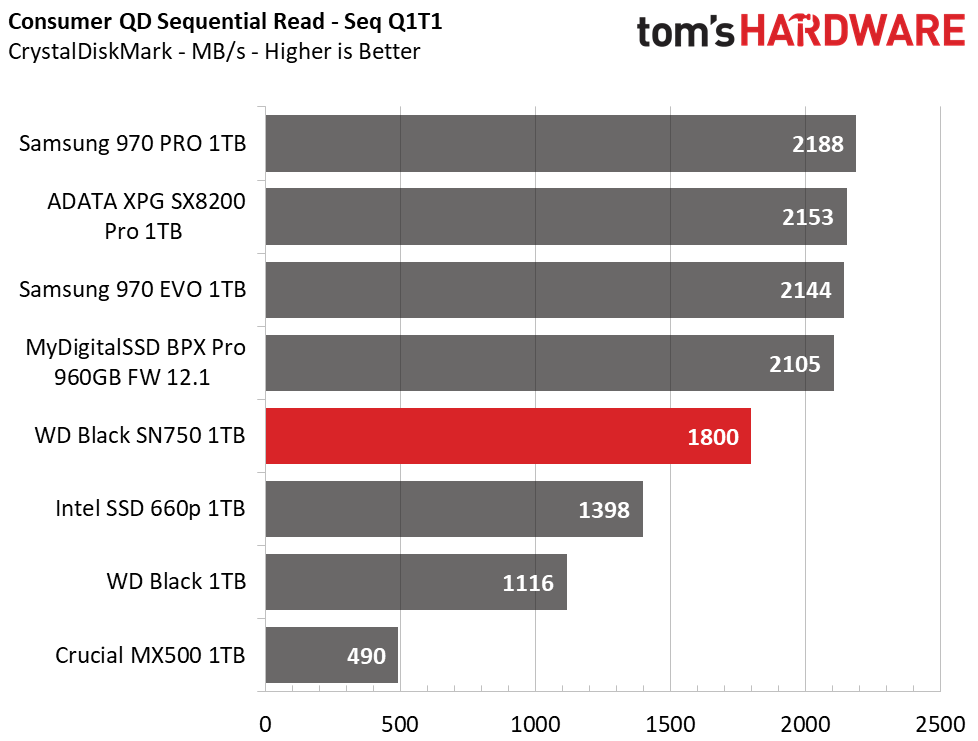

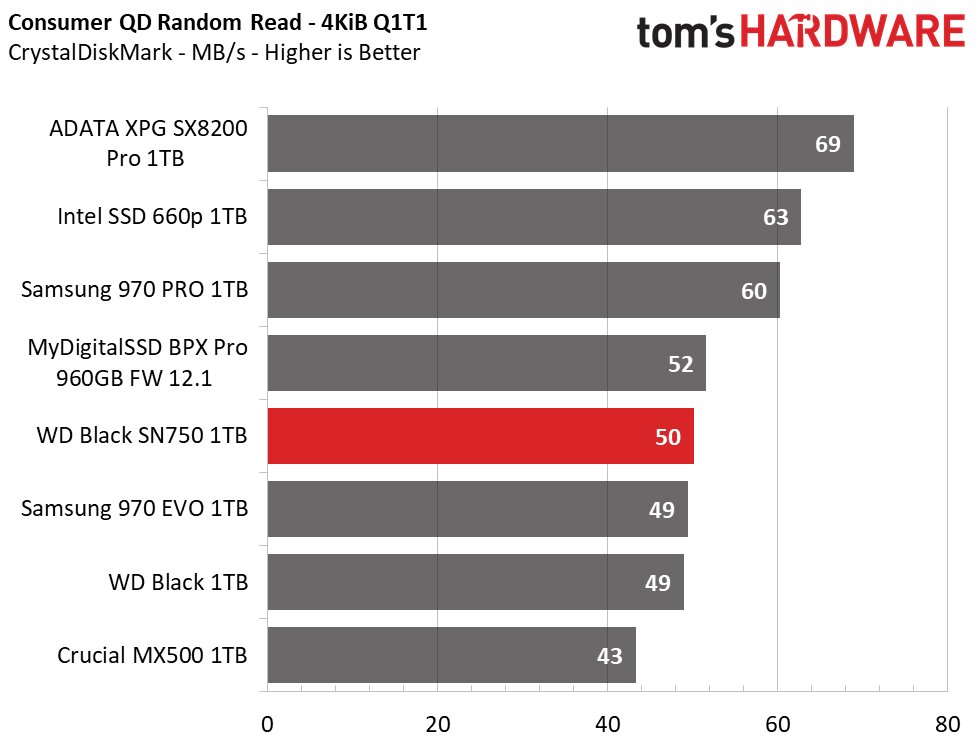



The CrystalDiskMark test results nearly match WD’s rated sequential specifications. Here the Black SN750 achieved 3,468MB/s of read throughput and 3,001MB/s of write performance at a queue depth (QD) of 32. Sequential performance at QD1 shows a huge improvement over the previous-gen model. The drive now reads at 1,800MB/s, a big jump over 1,116MB/s, but write speed remains similar. 4K random performance didn’t change much at QD1, either.
Sustained Sequential Write Performance
Official write specifications are only part of the performance picture. Most SSD makers implement an SLC cache buffer, which is a fast area of SLC-programmed flash that absorbs incoming data. Sustained write speeds can suffer tremendously once the workload spills outside of the SLC cache and into the "native" TLC or QLC flash. We hammer the SSDs with sequential writes for 15 minutes to measure both the size of the SLC buffer and performance after the buffer is saturated.

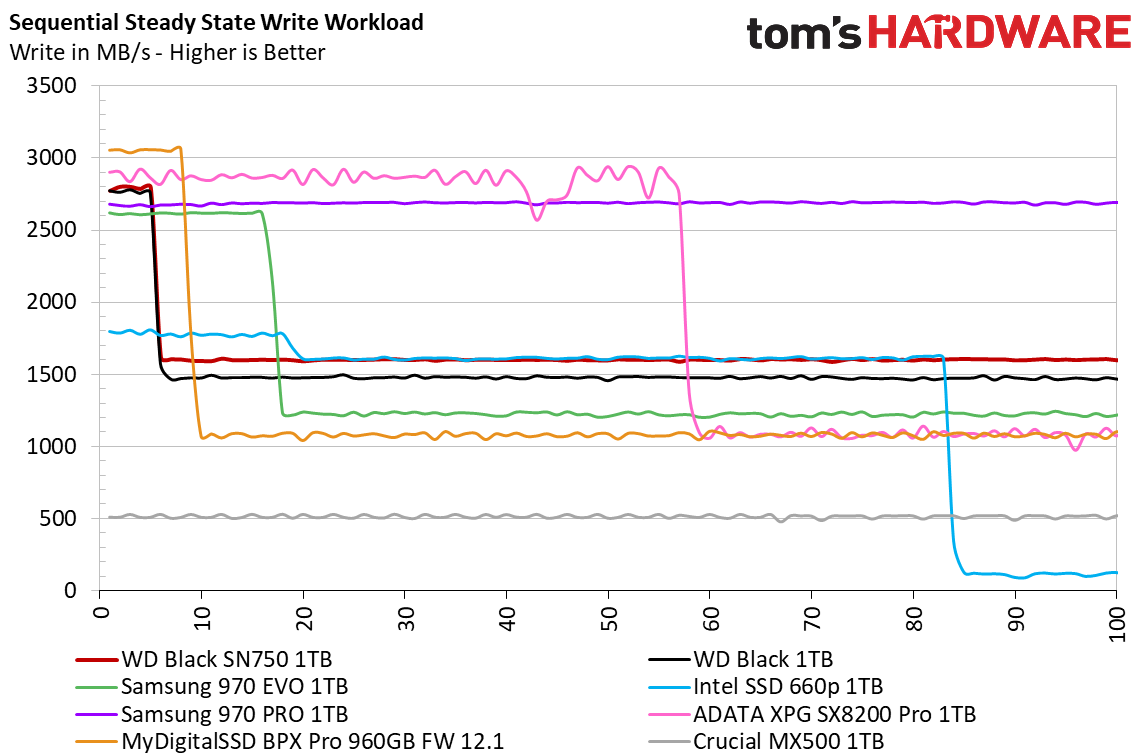
WD’s Black has a tiered SLC cache, dubbed nCache 3.0. WD designed this caching implementation to maintain higher write performance during extended workloads, and from the chart above, it does just that. After the drive writes roughly 14GB of data, performance degrades from 2.8GB/s write down to a fairly consistent 1.6GB/s. This is a 100MB/s improvement in base write performance over the previous model and outperforms everything but the Samsung 970 Pro. This makes it a great choice for media editors who consistently work with large video files.
Power Consumption
We use the Quarch HD Programmable Power Module to gain a deeper understanding of power characteristics. Idle power consumption is a very important aspect to consider, especially if you're looking for a new drive for your laptop. Some SSDs can consume watts of power at idle while better-suited ones sip just milliwatts. Average workload power consumption and max consumption are two other aspects of power consumption, but performance-per-watt is more important. A drive might consume more power during any given workload, but accomplishing a task faster allows the drive to drop into an idle state faster, which ultimately saves power.

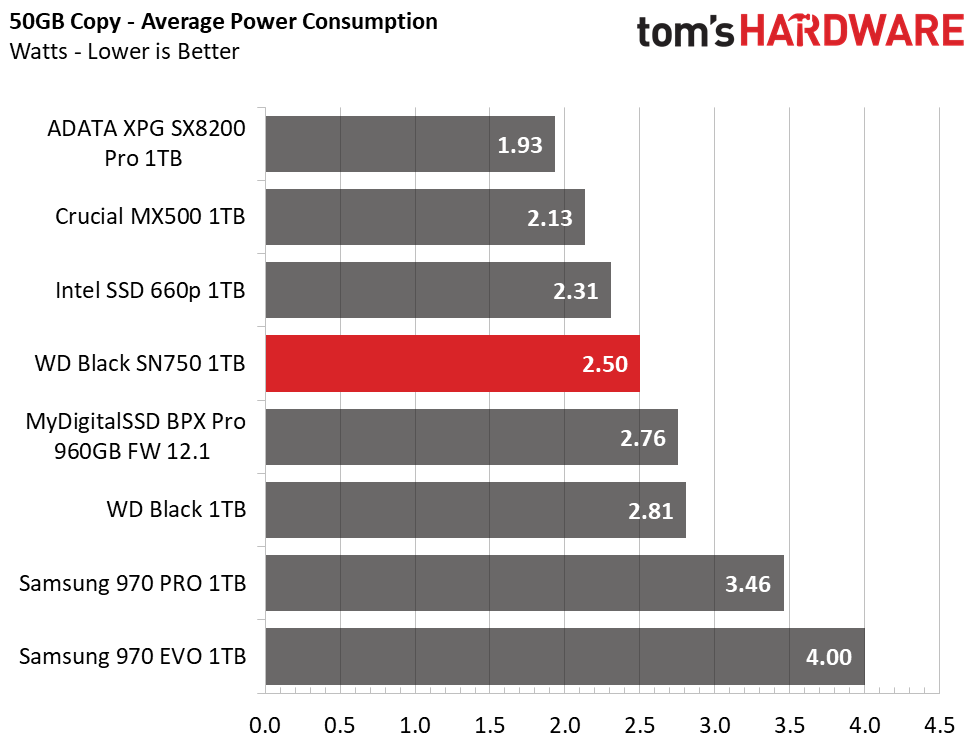
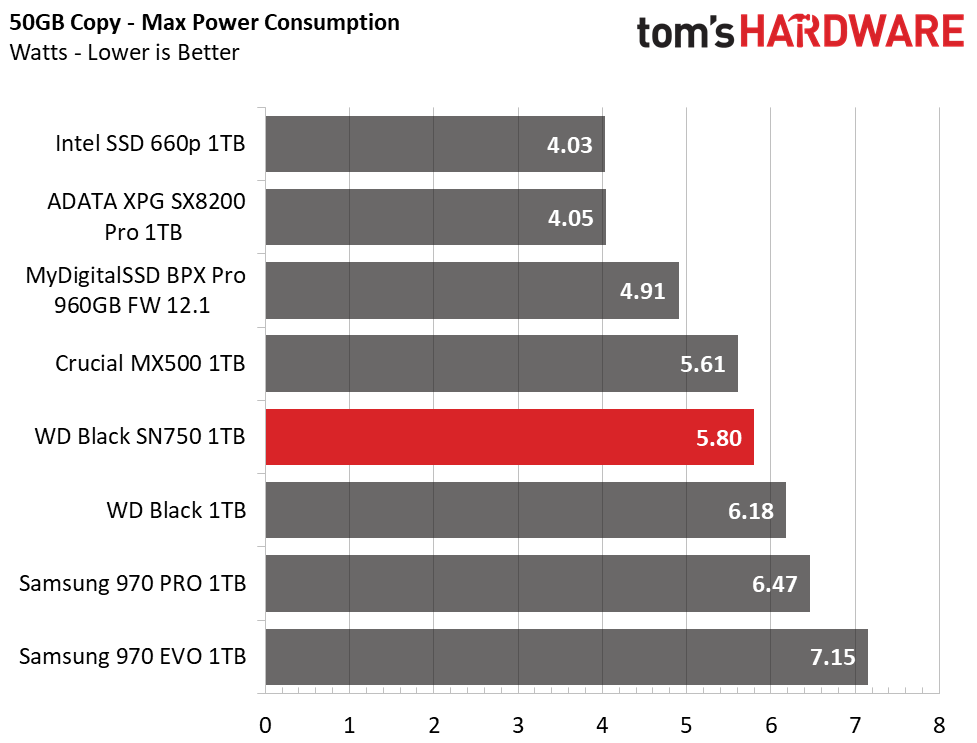


WD’s firmware team also worked to improve thermal and power efficiency. Under load, the Black SN750 shows a 20% improvement when copying our 50GB file folder. That ranks second behind the SX8200 Pro.
Idle power consumption, however, didn’t fare as well. The drive consumed 1.2W at idle with ASPM disabled. With the feature enabled, the drive consumes 0.6W. Other options, like the SX8200 Pro and Intel SSD 660P, consume much less power at idle and would be a better fit for laptops.
MORE: Best SSDs
MORE: How We Test HDDs And SSDs
MORE: All SSD Content

Sean is a Contributing Editor at Tom’s Hardware US, covering storage hardware.
-
jstanleydodson So this drive beats the 1TB 970 Evo in performance, yet it is priced to high? I think it is priced perfectly given that it beats the Evo.Reply -
jimmysmitty Gaming mode on an SSD. Seems as useful as the turbo button on late 80s/early 90s PCs.Reply -
NinjaNerd56 I bought one of these 2 years ago for a NUC server I was building.Reply
Yes, it ran 24 x 7 at 99% for 26 months but imagine my HAPPINESS when it went tits up at Xmas without warning.
It’s golden brown, as in toast. The Samsung in another machine that’s 4.5 years old?
Still kicking ass...
YMMV, WAC, WSL...... -
elbert WD manufactors their own Hard Drives and for those you can trust today. I would say reliability and over priced on the black edition. Pretty much all hard drives tho are over priced today. Now these SSD's aren't manufactured by WD and even if they were I would have a real worry of their reliability. Performances matters not when its low grade parts so I wouldn't pay nearly as much for those as say Samsung's or Crucial that have a proven track record in the SSD market.Reply -
poodie13 Yes, I would agree "... handcrafted ..." is a ridiculous description of a mass production sub-component. Even for a "designer case" these days that would sound silly.Reply
And "...and an updated military-style font..."
- Too much Marketing-Speak in this article but I it is just a trade announcement.
: but we'll have to wait for it to pass through the lab to verify those claims : -
BaRoMeTrIc Reply
Yeah they should have gone SLC and just stacked the flash on top of each othervplatson said:Same crappy TLC NAND. Skip...

